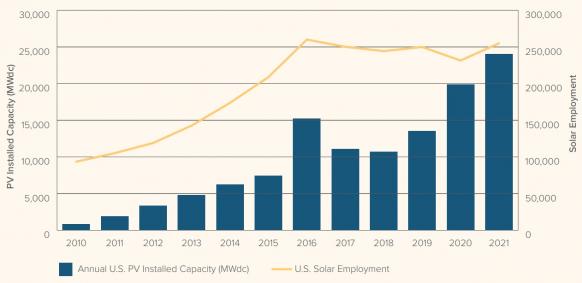U.S. $370 billion clean energy bill backed by crucial Senator; Europe way off renewable energy targets
The solar news you need to know.

Related Articles
U.S. Senator Manchin backs $370 billion clean energy package
Democrat Senator Joe Manchin agreed $370 billion of clean energy and climate measures in a new climate and drug bill seen as crucial for President Biden's climate goals.
Last month, Biden vowed to take executive action to reduce climate emissions after Manchin withdrew crucial support for climate legislation Democrats had hoped to pass before the summer recess. Manchin is Senator for coal-reliant West Virginia and his support is critical for passage of the legislation in the evenly divided Senate as it lacks any Republican backing.
The Inflation Reduction Act agreed by Manchin on July 27 extends tax credits for solar and wind and allows stand-alone storage projects to qualify for the first time. The bill also includes tax credits for manufacturing of solar and wind components.
The Act would "invest in domestic energy production and manufacturing and reduce carbon emissions by roughly 40% by 2030," Senate Majority Leader Chuck Schumer said. Biden aims to cut U.S. emissions by at least 50% by 2030 and fully decarbonise the power sector by 2035, a monumental challenge.
The tax credits in the bill will allow rapid deployment of renewable energy, create U.S. jobs and bolster energy security, the American Clean Power (ACP) association said.
"This is an 11th hour reprieve for climate action and clean energy jobs," ACP said.
Senate Democrats intend to vote on the Act through the budget reconciliation process which would allow passage with a majority in the Senate. The bill must also be approved by the House of Representatives.
Meanwhile, the Environmental Protection Agency (EPA) plans to use new limits on traditional pollutants like ozone and coal ash to help encourage the retirement of the nation’s remaining coal-fired power plants after the Supreme Court limited the agency’s ability to impose sweeping regulations, EPA chief Michael Regan told Reuters on July 29.
The Supreme Court ruled on June 30 to limit the EPA's authority to regulate greenhouse gas emissions from existing coal- and gas-fired power plants. The conservative court's 6-3 ruling restricted the EPA's authority under the Clean Air Act anti-pollution law in a case brought by the state of West Virginia.
U.S. adds 21,563 solar jobs in 2021, majority in installation
U.S. solar employment rose by 9% in 2021 to 255,037 jobs and around two thirds of new jobs were in installation and project development, according to the National Solar Jobs Census published by the Interstate Renewable Energy Council (IREC).
The solar installation sector added 14,350 jobs in 2021 and now employs around 168,960 workers, the report said. California is by far the largest solar job market, hosting 75,712 roles. Florida, Massachusetts, New York and Texas all boast over 10,000 solar workers.
“America’s solar industry came back strong from the pandemic to expand the clean energy workforce across all regions of the country,” IREC President Larry Sherwood said.
"There is potential for unprecedented job growth in the coming years if federal, state, and local leaders take action to expand clean energy use and address climate change,” Sherwood said.
U.S. solar employment vs installed capacity
(Click image to enlarge)
Source: Interstate Renewable Energy Council (IREC), July 2022.
President Biden aims to decarbonise the power sector by 2035 and a new climate bill being debated by Congress could significantly accelerate growth. Annual solar installations must triple to over 60 GW/year to meet Biden's climate goals.
Growth offers an opportunity for companies and governments to improve racial and gender diversity in the solar sector.
Black people represented only 8% of the solar workforce in 2021, IREC said, compared with around 15% in the gas industry.
Women represented only 30% of the solar workforce, compared with around 50% of the total U.S. labour force.
EU must remove solar, wind barriers to achieve climate targets
European Union members must remove barriers to solar and wind deployment to limit global warming to 1.5°C, independent climate think tank Ember said in a new report.
Annual solar and wind installations in the EU are forecast to reach only half of the 76 GW required by 2026 to meet the region's climate goals, Ember warned.
"Only a handful [of EU countries] are reaching required wind deployment rates, and key countries for solar deployment are also lagging behind," it said.
Permitting remains a key barrier for developers and the European Commission should enforce a two-year limit on permitting procedures and a new higher target of 45% renewable energy by 2030, Ember said.
Solar and wind permitting can take several years due to complex administrative processes and a lack of resources at permitting authorities. Several EU members are adapting national permitting procedures in a bid to speed up deployment.
In May, EU leaders agreed to designate areas for renewable energy development and streamline environmental assessments as part of measures to rapidly phase out Russian oil and gas supply.
Deployment rates required to limit global warming to 1.5°C should be transposed into national energy and climate plans (NECPs) submitted by EU members during the formal review process next year, Ember said.
National renewable energy auctions will need to be "significantly increased to capacities in-line with 2030 targets," it said.
Reuters Events

